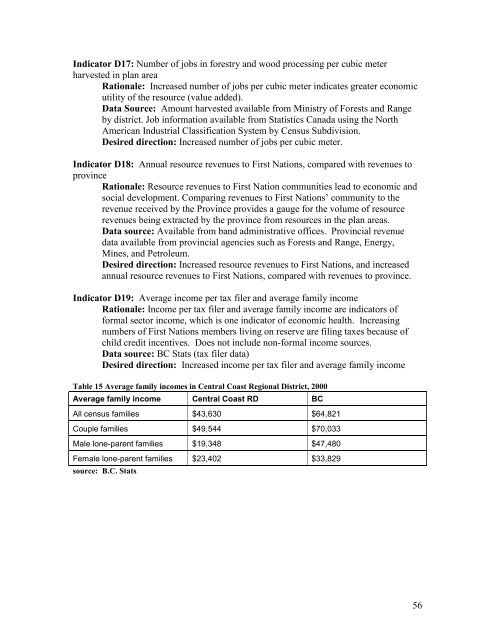Final report - Integrated Land Management Bureau
Final report - Integrated Land Management Bureau
Final report - Integrated Land Management Bureau
Create successful ePaper yourself
Turn your PDF publications into a flip-book with our unique Google optimized e-Paper software.
Indicator D17: Number of jobs in forestry and wood processing per cubic meter<br />
harvested in plan area<br />
Rationale: Increased number of jobs per cubic meter indicates greater economic<br />
utility of the resource (value added).<br />
Data Source: Amount harvested available from Ministry of Forests and Range<br />
by district. Job information available from Statistics Canada using the North<br />
American Industrial Classification System by Census Subdivision.<br />
Desired direction: Increased number of jobs per cubic meter.<br />
Indicator D18: Annual resource revenues to First Nations, compared with revenues to<br />
province<br />
Rationale: Resource revenues to First Nation communities lead to economic and<br />
social development. Comparing revenues to First Nations’ community to the<br />
revenue received by the Province provides a gauge for the volume of resource<br />
revenues being extracted by the province from resources in the plan areas.<br />
Data source: Available from band administrative offices. Provincial revenue<br />
data available from provincial agencies such as Forests and Range, Energy,<br />
Mines, and Petroleum.<br />
Desired direction: Increased resource revenues to First Nations, and increased<br />
annual resource revenues to First Nations, compared with revenues to province.<br />
Indicator D19: Average income per tax filer and average family income<br />
Rationale: Income per tax filer and average family income are indicators of<br />
formal sector income, which is one indicator of economic health. Increasing<br />
numbers of First Nations members living on reserve are filing taxes because of<br />
child credit incentives. Does not include non-formal income sources.<br />
Data source: BC Stats (tax filer data)<br />
Desired direction: Increased income per tax filer and average family income<br />
Table 15 Average family incomes in Central Coast Regional District, 2000<br />
Average family income Central Coast RD BC<br />
All census families $43,630 $64,821<br />
Couple families $49,544 $70,033<br />
Male lone-parent families $19,348 $47,480<br />
Female lone-parent families $23,402 $33,829<br />
source: B.C. Stats<br />
56
















